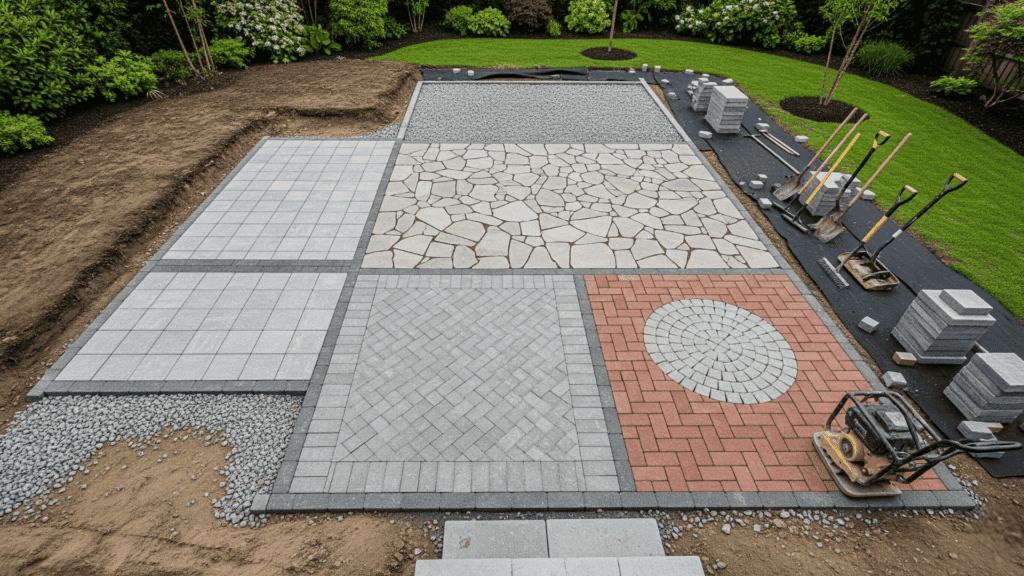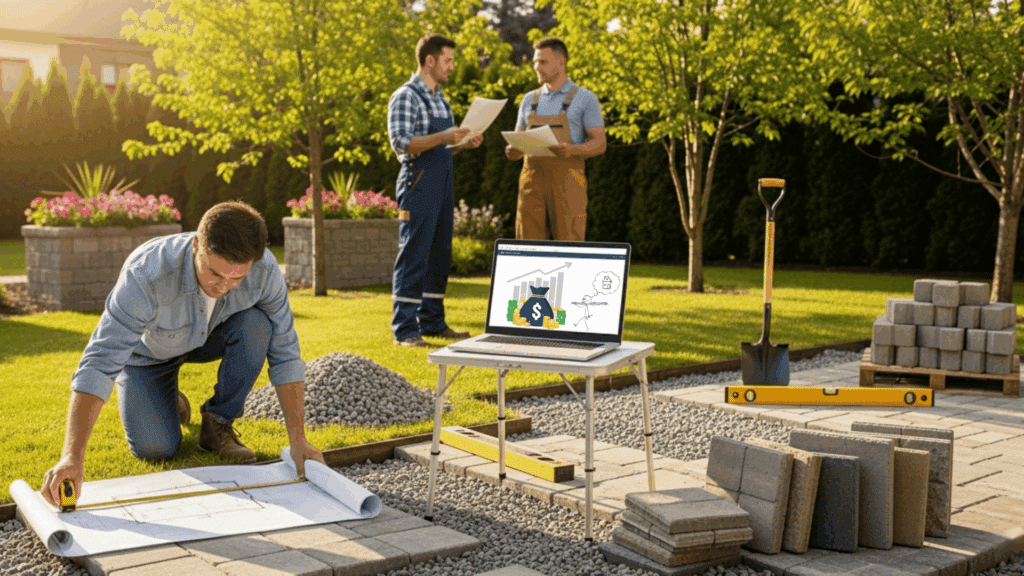When I first started planning my outdoor space, I quickly realized how important it was to understand the paver patio cost before pitching in.
Budgeting accurately not only helped me avoid unexpected expenses but also made sure I got the best value for my investment.
I learned that the total price depends on several factors, like the type of material, labor rates, the size of the patio, design complexity, and even extra fees for prep work or finishes.
By knowing these details upfront, I felt confident making choices that saved money and increased the return on my outdoor upgrade.
Paver Cost per Square Foot Based on Material
When I was comparing options, I realized that the biggest factor in paver patio cost is the material itself. On average, the paver cost per square foot can vary significantly depending on the style and quality.
| Paver Material | Cost per Sq Ft | Notes |
|---|---|---|
| Basic Concrete Pavers | $2 – $6 | Most affordable, standard option |
| Decorative/Interlocking | $8 – $15 | More aesthetic, often higher durability |
| Brick Pavers | $4 – $15 | Classic look, mid-to-high range |
| Natural Stone (e.g., Flagstone, Granite) | $8 – $30 | Premium appearance, highest cost |
| DIY Budget Options | $3 – $6 | Requires self-installation, excludes labor cost |
Labor & Installation Costs
Understanding patio pavers installation cost is crucial for managing your budget and avoiding surprises. Here are the key factors that influence what you’ll pay:
- Labor generally ranges from $10 to $20 per sq ft, influenced by design complexity and site conditions.
- Larger patios benefit from economies of scale, resulting in a lower cost per square foot.
- Intricate designs and uneven terrain increase labor and material waste costs.
- DIY installation saves money but requires skill, time, and the right tools.
- Premium projects with site prep, drainage, and custom features can reach $30 to $40 per sq ft.
Knowing these factors ensures smart budgeting and project planning for a patio that lasts and adds value.
Total Cost Estimates by Project Size
Estimating the total cost of a paver patio project depends largely on the size of the area and the quality of materials and installation services chosen.
Below is a breakdown of typical cost ranges for small, medium, and large patios, combining both materials and labor expenses for clearer budgeting.
| Patio Size | Total Cost Range | Cost Components | Notes |
|---|---|---|---|
| Small (100 sq ft) | $800 – $2,500 | Materials + Labor | Low-end materials and basic installation; DIY can reduce costs |
| Medium (200–300 sq ft) | $3,350 – $9,600 | Materials + Labor | Average around $3,350; higher cost with premium materials or complex designs |
| Large (400 sq ft) | $12,000 – $16,000 | Materials + Labor | High-end materials and professional installation; $30–40 per sq ft typical |
Pro Tip: Material choice and site preparation can significantly impact your budget. Plan for soil grading, drainage, and permits, as they can add to the overall cost. Gathering multiple quotes and considering long-term durability can help optimize your investment.
Key Factors Affecting Paver Patio Cost

Understanding the main factors that influence the cost of a paver patio helps homeowners make informed decisions and manage their budgets effectively.
These elements can drive costs up or down depending on the choices made in materials, site conditions, and design.
1. Material Type & Quality
How much it impacts: Roughly 40-50% of the total project cost
Why it’s Key: Sets the tone for durability, style, and long-term value
The choice between budget-friendly and premium paver materials greatly impacts the overall cost. Concrete pavers offer versatility and affordability, while natural stone or porcelain options deliver a high-end look with a higher price tag.
Selecting durable, quality materials ensures longevity and can increase ROI by upgrading curb appeal and property value.
2. Site Prep & Grading
How much it impacts: Can add 10-20% to total project costs
Why it’s Key: Creates a stable base essential for lasting results
Uneven terrain, soil removal, and grading significantly affect total expenses. Proper site preparation, including excavation and leveling, prevents future problems like settling or water drainage issues.
These preliminary steps add to the labor and material costs but protect the investment over time.
3. Design Complexity
How much it impacts: Adds about 15-25% to labor costs; up to 40% for complex sites
Why it’s Key: Balances aesthetics with budget and workmanship
Curves, intricate patterns (such as herringbone or borders), and multi-level patios require more labor and cutting, adding 15-40% more to installation time and costs.
Complex designs not only increase skill requirements but may also result in more waste and higher material needs.
4. Additional Materials
How much it impacts: Adds 10-15% to material and labor costs
Why it’s Key: Supports structure and longevity underfoot
Base layers like gravel, sand, landscape fabric, edging, and joint sand add roughly $5–12 per square foot to the budget.
These components are vital for a stable, long-lasting patio and contribute to proper drainage and weed control.
5. Location & Labor Rates
How much it impacts: Varies widely; can change cost by 10-30% depending on region
Why it’s Key: Local market conditions directly shape your final price
Regional pricing differences, including labor demand and material availability, influence quotes.
Labor rates fluctuate nationally and locally, making it essential to get multiple estimates and consider area-specific market forces when budgeting.
DIY vs. Professional Comparison
When deciding how to install a paver patio, understanding the cost differences and pros and cons of DIY versus professional installation is key.
Below is a side-by-side comparison to help weigh the financial and practical implications of each approach:
| Aspect | DIY Installation | Professional Installation |
|---|---|---|
| Cost per sq ft | $3 – $6 | $7 – $20+ |
| Key Savings | Labor costs | Quality, speed, and guaranteed results |
| Time Investment | Weeks to complete | Days to complete |
| Skill Required | High (tools, prep, pattern accuracy) | Low (handled by experts) |
| Tools/Equipment | Purchase or rental needed | Included in service |
| Risk of Mistakes | High (may cause costly fixes) | Low (expert craftsmanship) |
| Warranty | None | Often 1–5 years |
Note: Real-world costs can vary widely; for example, quotes for a 350 sq ft patio have ranged from $12,500 to $15,500 ($35–44 per sq ft).
How to Get Accurate Estimates?

Getting an accurate estimate for a paver patio project is essential for budgeting and avoiding costly surprises. Follow these practical steps to ensure you receive precise and reliable cost projections.
Step 1: Measure Your Project Area Precisely
Start by measuring the length and width of the space where you want the patio. Multiply these dimensions to find the total square footage.
For irregular shapes, break the area into rectangles or triangles, measure separately, and sum the totals to get an accurate size. Accurate measurements prevent ordering too much or too little material.
Step 2: Use Online Cost Calculators
Utilize trusted online paver cost calculators like HomeWyse, Lowe’s, or Omni Calculator to input your project dimensions and material preferences.
These tools provide detailed cost estimates covering materials and labor, giving you a strong benchmark early in the planning process to adjust your budget accordingly.
Step 3: Get Multiple Professional Quotes
Reach out to at least 2 to 3 local contractors or installers to request quotes.
Comparing several bids ensures competitive pricing and a clear understanding of market rates. It also helps spot any significant differences in scope or project approach.
Step 4: Ask for Itemized Breakdowns
Ensure each quote includes a detailed breakdown of costs: materials, labor, site prep, drainage, edging, and any other fees.
Itemized estimates increase transparency and help you compare apples to apples when reviewing proposals.
Step 5: Consider Potential Hidden Costs
Ask about additional factors that could affect pricing, such as permits, soil conditions, or accessibility challenges.
Being proactive about these potential costs ensures your estimate reflects the full scope of the project and minimizes unexpected expenses.
Budgeting Tips & Ways to Save
Planning a paver patio project on a budget doesn’t mean compromising on durability or style. These smart tips help you save money while ensuring a beautiful, lasting outdoor space.
- Choose less intricate layouts and basic paver types to reduce labor and material costs.
- Take on some prep or installation tasks yourself, like clearing the site or laying out basic patterns.
- Use locally sourced materials to lower delivery fees and support nearby suppliers.
- Order 10% extra material to cover waste and cuts, avoiding costly delays later.
- Rent or borrow tools instead of buying expensive equipment when doing DIY work.
With thoughtful planning and some hands-on effort, it’s possible to build a stunning patio that fits your budget and lifestyle.
Conclusion
After gaining a deeper understanding of paver patio costs, I feel confident that with the right knowledge and planning, anyone can create a beautiful, durable outdoor space without breaking the bank.
No matter if you decide to DIY or hire a professional, knowing the factors that influence price helps prevent surprises and maximize the value of your investment.
I encourage you to take these insights, measure your space carefully, gather accurate quotes, and begin designing your ideal patio today.
Don’t hesitate: start your path to crafting a splendid backyard retreat that will be enjoyed for years to come!
Check out other blogs on the website for more home improvement guides!













